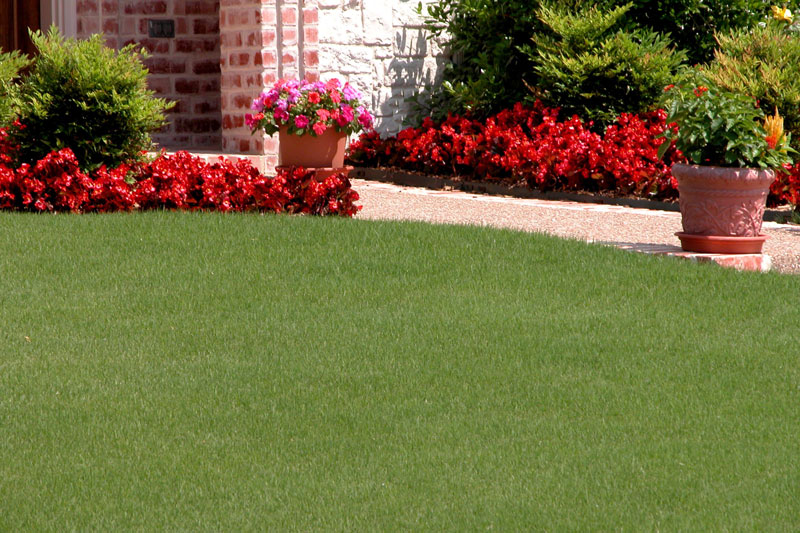Getting your lawn back on track

Never in the history of Texas lawn-keeping have there been so many people with so many problems. How do you sort through the crises so you can cope with the ones that are most currently pressing?
Start with the weeds…
Mowing will get rid of many weeds, plus it will reduce the humiliation factor. You may have to mow more often than you normally do, but such is the price of a well-groomed estate. In spite of your efforts, some weeds will persist, so you’ll have to make alternative plans.
• Broadleafed weeds (non-grasses, including dandelions, clover, dichondra, the less-common dollar weed and others) can be eliminated with an application of a broadleafed weedkiller. Most contain a blend of three or more herbicides for the best control of the weeds. Still, you’ll need to be patient to give them time to do their work. Personal opinion: It’s best to use a pump sprayer, not a hose-end type to apply them. Pumps apply less active ingredient, and they do so more uniformly.
• Weed grasses such as ryegrass, rescuegrass and annual bluegrass (Poa annua) are finishing up their winter growing cycles. There is no weedkiller you can use to eliminate existing unwanted grasses within turf without damaging your lawn. To prevent the same problem from happening this time next year, apply pre-emergent weedkiller granules the first week of September. This year’s crop will die out as it turns warmer in late April and May.

• Two especially troublesome weeds. There are two obnoxious weeds we’ve not yet addressed. Dallisgrass forms dense dinnerplate-sized clumps of grass in our lawns. It’s a perennial grass, so pre-emergents won’t help. The herbicide that was our go-to salvation has been removed from the market. Your options are to dig it out by hand or to spot-treat with a product containing only glyphosate. Use a trigger-squeeze bottle so you won’t have drift coating adjacent turf.
The final weed is nutsedge. It’s not a true grass, so grasskillers aren’t very effective on it. The original Image product does a great job of killing nutsedge, as does the more commercial product Sedgehammer (note the subtle misspelling).
Feeding your lawn…
Soil tests across Texas frequently show that only nitrogen is needed, especially for soils with a great deal of clay in their makeups. The middle number of a fertilizer’s analysis is phosphorus (promotes roots, flowers, and fruit), and it gets tied up in clay soils to excessive amounts. That’s why so many tests call for application of no phosphorus at all, whether for turf, landscapes, flowers, or vegetables.
Your first feeding could be made in the next couple of weeks (now in South Texas). Repeat the application early June, early August and early October for bermuda turf, and early June and early September for St. Augustine. Follow your feeding with a thorough watering, but don’t try to anticipate rainfall by fertilizing at the time soaking rains are expected. There is too much chance of runoff before the nutrients can dissolve and soak into the soil.
Mowing your turfgrass…
Mow your lawn at the recommended height this spring and summer. By keeping bermuda or St. Augustine toward the low end of their recommended ranges, you’ll encourage dense and spreading growth. Tall grass soon becomes weak grass. Mow low, and mow often.
Common bermuda should be cut at 1-1/4 to 1-1/2 inches, and St. Augustine at 2 to 2-1/2 inches. Try never to remove more than one-third of the leaf blade length at each mowing. That translates to every 5 or 6 days by late spring and summer.
If you find that your bermuda turf is browned immediately after you mow in June or July, you are probably cutting into leaf stubble. Raise the mower one notch so you’ll be leaving some of the leaf blade each time you mow. Leave it at that height the rest of the season, then drop it back one notch as you scalp in February next year.

If you have bare areas…
If you need to fill bare spots in your lawn, do so with exactly the same variety of grass that you have there already. The best way to do that is to dig plugs from your existing turf and checkerboard them into the bald areas.
Bermuda varieties, for example, vary a great deal in appearance, and you don’t want to get them mixed in the same lawn. However, if you’re absolutely sure of the type, you can certainly buy sod and cut it into 6-inch squares and plant them on 18-inch centers.
It is difficult to get bermuda seed to take root and grow within an existing lawn. Planting plugs is a much easier way to repair areas up to 10 or 15 feet across. Prime time for planting new seed or sod in North Texas is mid-April through mid-June (sooner if it turns hot early).
One final precaution: If the dead areas in your turf coincide with the shade beneath trees, your loss of grass may be due solely to shade, not to the drought. Planting new grass in that case would be a wasted effort. This is one of the most frequent mistakes gardeners make in Texas landscaping.

